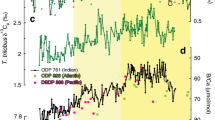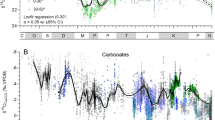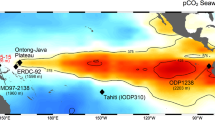Abstract
One of the great problems in the history of Earth’s climate is how to reconcile evidence for liquid water and habitable climates on early Earth with the Faint Young Sun predicted from stellar evolution models. Possible solutions include a wide range of atmospheric and oceanic chemistries, with large uncertainties in boundary conditions for the evolution and diversification of life and the role of the global carbon cycle in maintaining habitable climates. Increased atmospheric CO2 is a common component of many solutions, but its connection to the carbon chemistry of the ocean remains unknown. Here we present calcium isotope data spanning the period from 2.7 to 1.9 billion years ago from evaporitic sedimentary carbonates that can test this relationship. These data, from the Tumbiana Formation, the Campbellrand Platform and the Pethei Group, exhibit limited variability. Such limited variability occurs in marine environments with a high ratio of calcium to carbonate alkalinity. We are therefore able to rule out soda ocean conditions during this period of Earth history. We further interpret this and existing data to provide empirical constraints for carbonate chemistry of the ancient oceans and for the role of CO2 in compensating for the Faint Young Sun.
This is a preview of subscription content, access via your institution
Access options
Subscribe to this journal
Receive 12 print issues and online access
$259.00 per year
only $21.58 per issue
Buy this article
- Purchase on Springer Link
- Instant access to full article PDF
Prices may be subject to local taxes which are calculated during checkout



Similar content being viewed by others
References
Sagan, C. & Mullen, G. Earth and Mars: evolution of atmospheres and surface temperatures. Science 177, 52–56 (1972).
Feulner, G. The Faint Young Sun problem. Rev. Geophys. 50, RG2006 (2012).
Walker, J. C. G., Hays, P. B. & Kasting, J. F. A negative feedback mechanism for the long-term stabilization of the Earth’s surface temperature. J. Geophys. Res. 86, 9776–9782 (1981).
Berner, R. A., Lasaga, A. C. & Garrels, R. M. The carbonate–silicate geochemical cycle and its effect on atmospheric carbon dioxide over the past 100 million years. Am. J. Sci. 283, 641–683 (1983).
Kasting, J. F. Early Earth: Faint Young Sun redux. Nature 464, 687–689 (2010).
Kempe, S. & Degens, E. T. An early soda ocean? Chem. Geol. 53, 95–108 (1985).
Grotzinger, J. P. & Kasting, J. F. New constraints on Precambrian ocean composition. J. Geol. 101, 235–243 (1993).
Blättler, C. L. & Higgins, J. A. Calcium isotopes in evaporites record variations in Phanerozoic seawater SO4 and Ca. Geology 42, 711–714 (2014).
Nielsen, L. C. & DePaolo, D. J. Ca isotope fractionation in a high-alkalinity lake system: Mono Lake, California. Geochim. Cosmochim. Acta 118, 276–294 (2013).
Blake, T., Buick, R., Brown, S. & Barley, M. Geochronology of a Late Archaean flood basalt province in the Pilbara Craton, Australia: constraints on basin evolution, volcanic and sedimentary accumulation, and continental drift rates. Precambrian Res. 133, 143–173 (2004).
Awramik, S. M. & Buchheim, H. P. A giant, Late Archean lake system: the Meentheena Member (Tumbiana Formation; Fortescue Group), Western Australia. Precambrian Res. 174, 215–240 (2009).
Sakurai, R., Ito, M., Ueno, Y., Kitajima, K. & Maruyama, S. Facies architecture and sequence-stratigraphic features of the Tumbiana Formation in the Pilbara Craton, northwestern Australia: implications for depositional environments of oxygenic stromatolites during the Late Archean. Precambrian Res. 138, 255–273 (2005).
Sumner, D. Y. & Bowring, S. A. U–Pb geochronologic constraints on deposition of the Campbellrand Subgroup, Transvaal Supergroup, South Africa. Precambrian Res. 79, 25–35 (1996).
Beukes, N. J. Facies relations, depositional environments and diagenesis in a major early Proterozoic stromatolitic carbonate platform to basinal sequence, Campbellrand Subgroup, Transvaal Supergroup, southern Africa. Sediment. Geol. 54, 1–46 (1987).
Sumner, D. Y. & Grotzinger, J. P. Implications for Neoarchaean ocean chemistry from primary carbonate mineralogy of the Campbellrand–Malmani Platform, South Africa. Sedimentology 51, 1273–1299 (2004).
Hoffman, P. in Reefs, Canada and Adjacent Area (eds James, N. P., Geldsetzer, H. H. J. & Tebbull, G. E.) 38–48 (Canadian Society of Petroleum Geologists Memoir 13, 1989).
Hoffman, P., Bell, I., Hildebrand, R. & Thorstad, L. Geology of the Athapuscow aulacogen, east arm of Great Slave Lake, District of Mackenzie. Geol. Surv. Can. Pap. 77-1A, 117–129 (1977).
Sumner, D. Y. & Grotzinger, J. P. Herringbone calcite: petrography and environmental significance. J. Sediment. Res. 66, 419–429 (1996).
Buick, R. The antiquity of oxygenic photosynthesis: evidence from stromatolites in sulphate-deficient Archaean lakes. Science 255, 74–77 (1992).
Eriksson, K., Simpson, E., Master, S. & Henry, G. Neoarchaean (c. 2.58 Ga) halite casts: implications for palaeoceanic chemistry. J. Geol. Soc. 162, 789–799 (2005).
Hotinski, R., Kump, L. & Arthur, M. The effectiveness of the Paleoproterozoic biological pump: a δ13C gradient from platform carbonates of the Pethei Group (Great Slave Lake Supergroup, NWT). Geol. Soc. Am. Bull. 116, 539–554 (2004).
Fantle, M. S. & Tipper, E. T. Calcium isotopes in the global biogeochemical Ca cycle: implications for development of a Ca isotope proxy. Earth Sci. Rev. 129, 148–177 (2014).
Fantle, M. S. & DePaolo, D. J. Ca isotopes in carbonate sediment and pore fluid from ODP Site 807A: the Ca2+(aq)–calcite equilibrium fractionation factor and calcite recrystallization rates in Pleistocene sediments. Geochim. Cosmochim. Acta 71, 2524–2546 (2007).
Blättler, C. L., Henderson, G. M. & Jenkyns, H. C. Explaining the Phanerozoic Ca isotope history of seawater. Geology 40, 843–846 (2012).
DePaolo, D. J. Surface kinetic model for isotopic and trace element fractionation during precipitation of calcite from aqueous solutions. Geochim. Cosmochim. Acta 75, 1039–1056 (2011).
Higgins, J. A., Fischer, W. W. & Schrag, D. P. Oxygenation of the ocean and sediments: consequences for the seafloor carbonate factory. Earth Planet. Sci. Lett. 284, 25–33 (2009).
Kienert, H., Feulner, G. & Petoukhov, V. Faint Young Sun problem more severe due to ice-albedo feedback and higher rotation rate of the early Earth. Geophys. Res. Lett. 39, L23710 (2012).
Charnay, B. et al. Exploring the Faint Young Sun problem and the possible climates of the Archean Earth with a 3-D GCM. J. Geophys. Res. 118, 10414–10431 (2013).
Sheldon, N. D. Precambrian paleosols and atmospheric CO2 levels. Precambrian Res. 147, 148–155 (2006).
Shields, G. & Veizer, J. Precambrian marine carbonate isotope database: version 1.1. Geochem. Geophys. Geosyst. 3, 1–12 (2002).
Blättler, C. L., Miller, N. R. & Higgins, J. A. Mg and Ca isotope signatures of authigenic dolomite in siliceous deep-sea sediments. Earth Planet. Sci. Lett. 419, 32–42 (2015).
Young, E. D., Galy, A. & Nagahara, H. Kinetic and equilibrium mass-dependent isotope fractionation laws in nature and their geochemical and cosmochemical significance. Geochim. Cosmochim. Acta 66, 1095–1104 (2002).
Heuser, A. & Eisenhauer, A. The calcium isotope composition (δ44/40Ca) of NIST SRM 915b and NIST SRM 1486. Geostand. Geoanal. Res. 32, 311–315 (2008).
Hippler, D. et al. Calcium isotopic composition of various reference materials and seawater. Geostand. Newslett. 27, 13–19 (2003).
Jacobson, A. D., Andrews, M. G., Lehn, G. O. & Holmden, C. Silicate versus carbonate weathering in Iceland: new insights from Ca isotopes. Earth Planet. Sci. Lett. 416, 132–142 (2015).
Risacher, F. & Clement, A. A computer program for the simulation of evaporation of natural waters to high concentration. Comput. Geosci. 27, 191–201 (2001).
Hensley, T. M. Calcium Isotopic Variation in Marine Evaporites and Carbonates: Applications to Late Miocene Mediterranean Brine Chemistry and Late Cenozoic Calcium Cycling in the Oceans PhD thesis, Univ. California (2006).
Zeebe, R. E. & Wolf-Gladrow, D. A. CO2 in Seawater: Equilibrium, Kinetics, Isotopes Vol. 65 (Elsevier Oceanography Series, 2001).
Fantle, M. S. & Higgins, J. The effects of diagenesis and dolomitization on Ca and Mg isotopes in marine platform carbonates: implications for the geochemical cycles of Ca and Mg. Geochim. Cosmochim. Acta 142, 458–481 (2014).
Blake, T. S. Cyclic continental mafic tuff and flood basalt volcanism in the Late Archaean Nullagine and Mount Jope Supersequences in the eastern Pilbara, Western Australia. Precambrian Res. 107, 139–177 (2001).
Lipple, S. Definitions of new and revised stratigraphic units of the eastern Pilbara region. Annu. Rep.–West. Aust. Dep. Mines 1974, 98–103 (1975).
Bolhar, R. & Van Kranendonk, M. J. A non-marine depositional setting for the northern Fortescue Group, Pilbara Craton, inferred from trace element geochemistry of stromatolitic carbonates. Precambrian Res. 155, 229–250 (2007).
Thorne, A. & Trendall, A. F. Geology of the Fortescue Group, Pilbara Craton, Western Australia Vol. 144 (Geological Survey of Western Australia, 2001).
Knoll, A. H. & Beukes, N. J. Introduction: initial investigations of a Neoarchean shelf margin-basin transition (Transvaal Supergroup, South Africa). Precambrian Res. 169, 1–14 (2009).
Sumner, D. Y. & Beukes, N. J. Sequence stratigraphic development of the Neoarchean Transvaal carbonate platform, Kaapvaal Craton, South Africa. South Afr. J. Geol. 109, 11–22 (2006).
Truswell, J. & Eriksson, K. Stromatolitic associations and their palaeo-environmental significance: a re-appraisal of a Lower Proterozoic locality from the northern Cape Province, South Africa. Sediment. Geol. 10, 1–23 (1973).
Paris, G., Adkins, J., Sessions, A., Webb, S. & Fischer, W. Neoarchean carbonate-associated sulfate records positive Δ33S anomalies. Science 346, 739–741 (2014).
Sami, T. T. & James, N. P. Peritidal carbonate platform growth and cyclicity in an early Proterozoic foreland basin, Upper Pethei Group, northwest Canada. J. Sediment. Res. 64, 111–131 (1994).
Sami, T. T. & James, N. P. Synsedimentary cements as Paleoproterozoic platform building blocks, Pethei Group, northwestern Canada. J. Sediment. Res. 66, 209–222 (1996).
Hotinski, R. M. Life’s Influence on the Sedimentary Record: The Interplay of Ocean Chemistry, Circulation, and the Biological Pump PhD thesis, Univ. Pennsylvania State (2000).
Acknowledgements
This work was supported by a grant from the Simons Foundation (SCOL 339006 to C.L.B.). S. A. Maclennan and A. M. Campion aided J.J.K. in collecting Tumbiana samples. D. P. Santiago Ramos and E. A. Lundstrom contributed to laboratory analyses.
Author information
Authors and Affiliations
Contributions
C.L.B. conceived of the study; L.R.K., W.W.F., G.P. and J.J.K. conducted field work and collected samples; C.L.B. and J.A.H. obtained and analysed the data.
Corresponding author
Ethics declarations
Competing interests
The authors declare no competing financial interests.
Supplementary information
Supplementary Information
Supplementary Information (PDF 1897 kb)
Supplementary Information
Supplementary Information (XLSX 49 kb)
Rights and permissions
About this article
Cite this article
Blättler, C., Kump, L., Fischer, W. et al. Constraints on ocean carbonate chemistry and pCO2 in the Archaean and Palaeoproterozoic. Nature Geosci 10, 41–45 (2017). https://doi.org/10.1038/ngeo2844
Received:
Accepted:
Published:
Issue Date:
DOI: https://doi.org/10.1038/ngeo2844
This article is cited by
-
Investigating Europa’s Habitability with the Europa Clipper
Space Science Reviews (2023)
-
Earth’s long-term climate stabilized by clouds
Nature Geoscience (2021)
-
Archaean phosphates: a case study of transformation processes in apatite from the Barberton greenstone belt
Contributions to Mineralogy and Petrology (2019)



